- 文字サイズ
-
- 大きく
- 標準
- Traditional cultural activity emergency support project "Gigei Seizui Esprit of Aichi Performing Arts"
Traditional cultural activity emergency support project "Gigei Seizui Esprit of Aichi Performing Arts"
Aichi prefecture is the center of Japanese art and culture. It leads the nation in extracurricular activities, where traditional culture is passed down to the younger generations.
The Kyoho Reforms, Meiji Restoration, and World War II were critical times for art and culture. Aichi became a place for art and culture to be gathered, protected and developed; therefore, Aichi’s esprit lies in evolving and inspiring the arts and culture to new heights during challenging times.
Even today, as COVID-19 has changed our way of life, the challenge is how to incorporate art and culture into our daily lives and inspire new opportunities during this time of crisis. Our video presentations is our answer to such a challenge.
Aichi Prefecture broadcasted traditional culture performances on cable television and online in order to support traditional cultural organizations of Aichi whose performance opportunities have been compromised for reasons of COVID-19-related cancellations.
【Supervisor】
Bunkichi Yasuda Visiting Professor at Tokai Gakuen University, Professor Emeritus at Nanzan University
<Noh> Kanze School of Noh
【About the Kanze School of Noh】
The Kanze School was one of the Sarugaku performing arts that was active in Yamato (old name for Nara Prefecture) during the Nanboku-cho period (1336-1392). The school belonged to the Yuzaki troupe, and Kan-ami who served as the tayu (leading actor in the troupe) was the first generation. Father and son – Kan-ami and Zeami – refined the performing art and gave it depth. The school was characterized by graceful, delicate expressions.
【Program introduction】
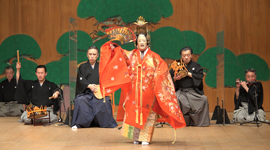 Program①Noh Play Hagoromo (Celestial Feather Robe)
Program①Noh Play Hagoromo (Celestial Feather Robe)
Hagoromo, based on the popular folklore, Legend of Hagoromo, is filled with the traditional charm of Noh.
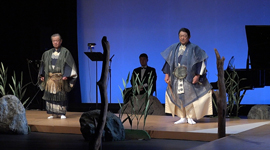 Program②New Noh Masu (Trout)
Program②New Noh Masu (Trout)
Masu is Kan-oh Hisada’s new Noh play, featuring fishermen and trout at a mountain stream, collaborating with Schubert’s composition“Trout” performed by a string quintet accompanied by a vocalist.
<Kyogen> Nomura Family of Izumi School Kyogen
【About the Nomura Family of Izumi School Kyogen】
One of the three styles (Yamawaki, Nomura, Miyake) of the Izumi School, the Nomura Family performed Kyogen at various locations for the Owari Tokugawa family and Higo Hosokawa family throughout the Edo period (1776-1868). After the Meiji Restoration (1868), the school overcame the perils of earthquakes and wars and is the only school in the Kyogen world to be succeeded to Matasaburo Nobuhiro Nomura XIII without extinction or interruption. After the War, the headquarters was relocated to Nagoya, a place closely connected with the troupe.
Led by Matasaburo Nobuyuki Nomura XIV, the troupe performs, promotes, and teaches the art to a wide range of generations.
【Program introduction】
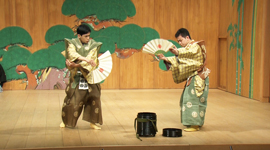 Program①Classical Kyogen Busu (The Delicious Poison)
Program①Classical Kyogen Busu (The Delicious Poison)
Busu tells a humorous story of two servants who are told to stay away from a container filled with a poison called "busu". Two young performers perform this renowned Kyogen play, that was adapted from the Shasekishu (Sand and Pebbles, a collection of Buddhist stories) compiled at Nagoya's Choboji Temple.
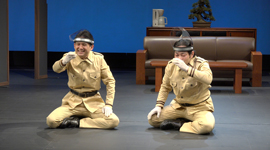 Program②Challenge Kyogen Booby
Program②Challenge Kyogen Booby
The setting for the classical Kyogen Busu is replaced with the present time. In the modern version, written by Matasaburo Nomura, the characters are played by the fathers of the two young performers in the classical version. This play was performed for the first time in Japan.
<Koto> Soukyoku-Chikage-No-Kai
【About Soukyoku-Chikage-No-Kai】
Since establishment in 1960, Soukyoku-Chikage-No-Kai made efforts to popularize and advance koto music and has attracted a wide range of age groups for its creative activities based on the classics. The group arranges traditional Japanese music in a modern way and is highly acclaimed for its active works, including overseas performances. The group received the FY 1993 Aichi Prefectural Art and Culture Encouragement Prize Culture Award (for groups).
【Program introduction】
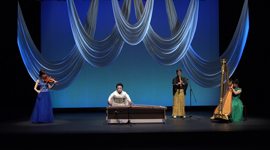 Program①"Rokudan no Shirabe","Nihon no Kokorone"
Program①"Rokudan no Shirabe","Nihon no Kokorone"
The beautiful mind of Japan is expressed with music as Tamiko Asai's koto is accompanied by a shakuhachi, violin, and harp in the famous "Rokudan no Shirabe" and "Nihon no Kokorone" (medley of songs).
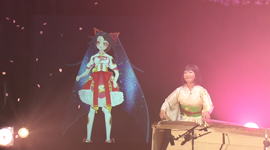 Program②Media Art of Japanese Tradition feat. Koto "Senbonzakura"
Program②Media Art of Japanese Tradition feat. Koto "Senbonzakura"
"Senbonzakura" is brought to you by a Japanese orchestra of Rie Asai's koto accompanied by the fue (flute) and taiko (stick drums) with Aichi Tourism Virtual Supporter Kimino Miya.
<Buyo> Nishikawa School
【About the Nishikawa School】
In 1841, Koisaburo Nishikawa I moved from Edo (old name for Tokyo) to Nagoya and became the first Nishikawa School headmaster and laid the foundation for the school in Nagoya. One of the five major schools of Nihon Buyo (Japanese classical dance), the Nishikawa School was created in the early days of Nihon Buyo history.
【Program introduction】
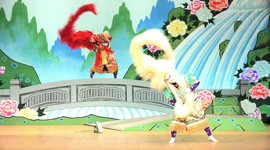 Program①Renjishi (Two Lions)
Program①Renjishi (Two Lions)
Against the backdrop of Shakkyo (The Stone Bridge, a Noh play) unique to Nagoya, Kazumasa Nishikawa and company perform Renjishi, which depicts a father and son overcoming adversities, sending best wishes to people battling the coronavirus pandemic.
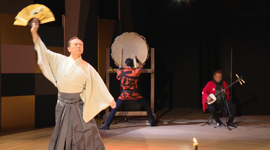 Program②Japanese Buyo Dance Session with Shamisen and Wadaiko
Program②Japanese Buyo Dance Session with Shamisen and Wadaiko
In a session with dynamic shamisen and wadaiko (Japanese drum) and Japanese Buyo dance by Kazumasa Nishikawa, the free and open dance style expresses a release from the world locked down by the pandemic.
<Kado> Ishida Ikebana Association
【About the Ishida Ikebana Association】
Founded in Nagoya in 1922, Ishida School Kado (traditional flower arrangement) is characterized by the elegant expressions and speed in which the flowers and trees are arranged.
Shusui Ishida, the current chairman of the school, has enthusiastically conducted creative research for many years, spreading the study of ikebana and exhibiting flower arrangements in Japan and overseas. His masterpiece focusing on environmental issues presented at the EXPO 2005 Aichi and 2010 COP 10 was well received. He received the FY 2013 Aichi Prefectural Art and Culture Encouragement Prize Culture Award.
【Program introduction】
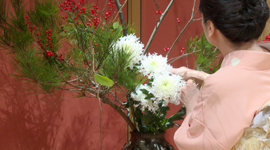 Program①Classic Flower Arrangement featuring Aichi's Kagariben-giku
Program①Classic Flower Arrangement featuring Aichi's Kagariben-giku
Kagariben-giku, a new species of chrysanthemum with beautiful fissured petals grown in Aichi, the top producer of flowers in Japan, is used in the Ishida School classical flower arrangement.
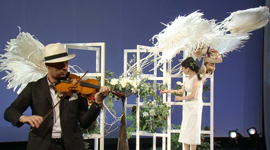 Program②Flower Performance using Aichi's Kagariben-giku Set to Beautiful Music
Program②Flower Performance using Aichi's Kagariben-giku Set to Beautiful Music
A large object is made with Kagariben-giku in a Kado (classical flower arrangement) performance set to video projections and a live accordion and violin performance.
